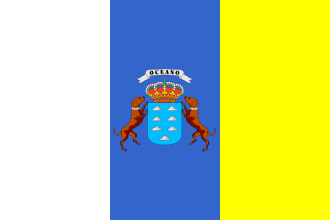 The Canary Islands (pronounced /kəˈnɛəriː ˈaɪləndz/, colloquially also known as the Canaries; Spanish:Islas Canarias, pronounced [ˈizlas kaˈna.ɾjas]; are a Spanish archipelago which, in turn, forms one of the Spanish Autonomous Communities and an Outermost Region of the European Union. The archipelago is located just off the northwest coast of mainland Africa, 100 km west of the disputed border between Morocco and the Western Sahara. The sea currents that depart from Canary’s coasts used to lead ships away to America. The islands from largest to smallest are: Tenerife,Fuerteventura, Gran Canaria, Lanzarote, La Palma, La Gomera, El Hierro, La Graciosa, Alegranza andMontaña Clara.
The Canary Islands (pronounced /kəˈnɛəriː ˈaɪləndz/, colloquially also known as the Canaries; Spanish:Islas Canarias, pronounced [ˈizlas kaˈna.ɾjas]; are a Spanish archipelago which, in turn, forms one of the Spanish Autonomous Communities and an Outermost Region of the European Union. The archipelago is located just off the northwest coast of mainland Africa, 100 km west of the disputed border between Morocco and the Western Sahara. The sea currents that depart from Canary’s coasts used to lead ships away to America. The islands from largest to smallest are: Tenerife,Fuerteventura, Gran Canaria, Lanzarote, La Palma, La Gomera, El Hierro, La Graciosa, Alegranza andMontaña Clara.
The Canary Islands have great natural attractions, climate and beaches making the islands a majortourist destination, being visited each year by about 12 million people. Among the islands, Tenerife has the most number of tourists received annually, followed by Gran Canaria and Lanzarote. The archipelago’s principal tourist attraction is the Teide National Park (in Tenerife) where the highest mountain in Spain and third largest volcano in the world (Mount Teide) is located; it receives over 2.8 million visitors annually.
The Canary Islands currently has a population of 2,098,593 inhabitants, making it the eighth most populous of Spain’s autonomous communities, with a density of 281.8 inhabitants per km². The total area of the archipelago is 7447 km². It also enjoys sub-tropical climate with longer hot days in summer and cooler days in winter.
The status of capital city is shared by the cities of Santa Cruz de Tenerife and Las Palmas de Gran Canaria, which in turn are the capitals of the provinces of Santa Cruz de Tenerife and Las Palmas. Until 1927 Santa Cruz de Tenerife was the only capital. The third largest city of the Canary Islands is San Cristóbal de La Laguna (City World Heritage Site) on the island of Tenerife.
Known in ancient times as the “Fortunate Islands,” they were written about by both Plutarch and Pliny the Elder. Believed to be the western limit of the world, they were visited in the Middle Ages by Arabs, Genoese, Majorcans, Portuguese, and French. They were taken by Castile in 1404, and their indigenous inhabitants, the Guanche and Canario, were gradually conquered during the 15th century. In 1479, the Treaty of Alcácovas between Portugal and Spain recognized Spanish sovereignty over the Canaries; the conquest of the Guanches, the indigenous Berber inhabitants of the islands, was completed in 1496. The islands became an important base for voyages to the Americas. The Canaries were frequently raided by pirates and privateers; Las Palmas beat off Francis Drake in 1595 but was ravaged by the Dutch in 1599. The Canary Islands became an autonomous region in 1982.
The music of the Canary Islands reflects its cultural heritage. The islands used to be inhabited by the Guanches which are related to Berbers; they mixed with Spaniards, who live on the islands now. A variant of Jota is popular, as is Latin music, which has left its mark in the form of the timple guitar. There has been a strong connection with Cuban music, Venezuelan, Puerto Rican, and other Caribbean countries both through commerce and migration.
The economy is based primarily on tourism, which makes up 32% of the GDP. Construction makes up nearly 20% of the GDP and tropical agriculture, primarily bananas and tobacco, are grown for export to Europe and the Americas. Ecologists are concerned that the resources, especially in the more arid islands, are being overexploited but there are still many agricultural resources like tomatoes, potatoes, onions, cochineal, sugarcane, grapes, vines, dates, oranges,lemons, figs, wheat, barley, maize, apricots, peaches and almonds.
The economy is € 25 billion (2001 GDP figures). The islands experienced continuous growth during a 20 year period, up until 2001, at a rate of approximately 5% annually. This growth was fueled mainly by huge amounts of Foreign Direct Investment, mostly to develop tourism real estate (hotels and apartments), and European Funds (near € 11 billion euro in the period from 2000 to 2007), since the Canary Islands are labelled Region Objective 1 (eligible for euro structural funds). Additionally, the EU allows the Canary Islands Government to offer special tax concessions for investors who incorporate under the Zona Especial Canaria (ZEC) regime and create more than 5 jobs.
Notes from Wikipedia and Answers.com









